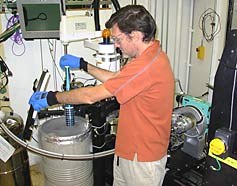
Handy Links
SLAC News Center
SLAC Today
- Subscribe
- Archives: Feb 2006-May 20, 2011
- Archives: May 23, 2011 and later
- Submit Feedback or Story Ideas
- About SLAC Today
SLAC News
Lab News
- Interactions
- Lightsources.org
- ILC NewsLine
- Int'l Science Grid This Week
- Fermilab Today
- Berkeley Lab News
- @brookhaven TODAY
- DOE Pulse
- CERN Courier
- DESY inForm
- US / LHC
SLAC Links
- Emergency
- Safety
- Policy Repository
- Site Entry Form

- Site Maps
- M & O Review
- Computing Status & Calendar
- SLAC Colloquium
- SLACspeak
- SLACspace
- SLAC Logo
- Café Menu
- Flea Market
- Web E-mail
- Marguerite Shuttle
- Discount Commuter Passes
-
Award Reporting Form
- SPIRES
- SciDoc
- Activity Groups
- Library
Stanford
Around the Bay
JCSG Celebrates Its 500th Structure
 On October 29, the Joint Center for Structural Genomics (JCSG)—in which SLAC plays an integral role—celebrated a major milestone as it deposited its 500th unique protein structure into the
Protein Data Bank (PDB). A protein's 3D structure dictates its function—including how it interacts with other proteins, how it catalyzes chemical reactions and how it might be inhibited or activated by drugs.
By determining structures representative of large protein families from a wide range of genomes, the JCSG seeks to illuminate key aspects of biology, chemistry and medicine that span from neurodegenerative disease to human evolution.
On October 29, the Joint Center for Structural Genomics (JCSG)—in which SLAC plays an integral role—celebrated a major milestone as it deposited its 500th unique protein structure into the
Protein Data Bank (PDB). A protein's 3D structure dictates its function—including how it interacts with other proteins, how it catalyzes chemical reactions and how it might be inhibited or activated by drugs.
By determining structures representative of large protein families from a wide range of genomes, the JCSG seeks to illuminate key aspects of biology, chemistry and medicine that span from neurodegenerative disease to human evolution.
The process of depositing a protein structure into the PDB begins with the Bioinformatics Core (based at the University of California San Diego and the Burnham Institute for Medical Research) selecting the targets to be investigated and the Crystallomics Core (based at The Scripps Research Institute and the Genomics Institute of the Novartis Research Foundation) producing soluble proteins that are then crystallized. Researchers at SLAC's Stanford Synchrotron Radiation Laboratory (SSRL) then use x-ray diffraction to map out the atomic structure of each crystallized protein. This Structure Determination Core (SDC) group determines the 3D structures and deposits the structural coordinates and diffraction data into the PDB, where they are freely available to the scientific community.
"Together, the Institutes in our consortium have established a very effective pipeline," said SLAC's Ashley Deacon, who leads the SDC. "We have developed new technologies and automated the various steps of the process to scale up not only production, but also to increase the efficiency, lower the cost and increase the quality of the structures determined."
SSRL has contributed to the development of robotic hardware to process and evaluate the crystal samples, enabling fast sample turn-around at the beamlines, and has generated novel software programs for high through-put structure determination. "Because the beamline is fully automated, we can control almost every step in our experiment from any computer," said Jessica Chiu, who manages crystal screening and data collection activities at SDC. "We can be at home, or in another country, and still screen crystals around the clock. This allows us to attain maximal throughput at the beamlines with minimal human intervention."
The determination of 500 structures is a tremendous accomplishment, and a testament to the talented scientific team and to the success of their automated, highly efficient operation. "We've doubled the rate at which we solve new structures since 2005," Deacon reported, "and we're still getting faster. But we won't compromise quality. The best way to speed things up is to get the best quality data you possibly can."
More information More information on all of the structures solved and deposited by the JCSG can be found at the JCSG Structure Gallery.
JCSG is funded by the NIH National Institute of General Medical Sciences, Protein Structure Initiative U54GM074898.
—Elizabeth Buchen, SLAC Today, November 1, 2007
Above image: Ashley Deacon loads samples of crystallized proteins into an automated sample mounting system.